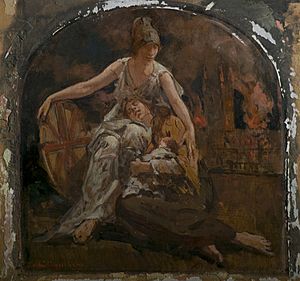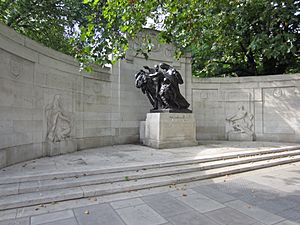Belgian refugees in Britain during the First World War facts for kids

During the First World War (1914-1918), many people from Belgium had to leave their homes. They were called Belgian refugees and a lot of them came to the United Kingdom.
It's hard to know exactly how many Belgians came to Britain during the war. This is because records were not always complete. Experts think between 225,000 and 265,000 refugees arrived. This number does not include the 150,000 Belgian soldiers who visited Britain or the 25,000 wounded soldiers who recovered there.
Contents
Places That Helped Refugees
Many places across Britain opened their doors to Belgian refugees. Here are some of them:
London and Nearby Areas
- Millfield House in Edmonton, North London, has a long history. It was once a school for children from workhouses. When World War I started, the school closed. The house was then used to shelter Belgian refugees. Later, it became a hospital.
- Crosby Hall in Chelsea, London, is a very old building. It used to be the home of Sir Thomas More. During the First World War, it helped Belgian refugees and wounded soldiers. A special plaque was put inside Crosby Hall after the war. It thanks the Chelsea War Refugee Committee for helping the Belgians. The famous British writer Henry James wrote about the refugees' experiences there.
- Dartford is a town in Kent. During World War I, many Belgian refugees arrived there. The town could not fit everyone, so many people stayed with local families who volunteered to help.
- Alexandra Palace and Earls Court were big exhibition buildings in London. In September 1914, these buildings were used to provide beds for Belgian refugees. By October 1914, about 8,000 beds were ready in these two places, with another 4,000 elsewhere in London.
Midlands and North England
- The area of Stoke Heath, Coventry grew a lot during the First World War because of the need for factory workers. During this time, Stoke Heath welcomed many Belgian refugees. A school built in 1915, Stoke Heath Junior & Infants School, was a main meeting point for the community.
- The Porch House in Nantwich, Cheshire, is a large old house. During the First World War, it housed refugees from Belgium. Because of this, people often called it "Belgium House."
- The Spalding Gentlemen's Society in Spalding, Lincolnshire, is a very old group that studies history and culture. Their museum opened in 1911. The beautiful carved panels on the outside of the museum were made by Jules Tuerlinckx. He was a Belgian refugee from Malines during the First World War.
- Royton is a town in Greater Manchester. During World War I, a building called Royton Hall was used to house Belgian refugees.
- Shropshire county hosted over 400 refugees starting in September 1914. Most of them lived in the area of Atcham, and many stayed at Cound Hall.
South Coast and Scotland
- The town of Folkestone in Kent became home to about 65,000 Belgian refugees during the First World War. The port there was a main place for soldiers to leave for the battlefields in France and Belgium. Many houses and hotels in Folkestone were used for the hundreds of thousands of soldiers, including Canadian troops.
- The Haven Hotel in Sandbanks, near Poole, Dorset, is a hotel on the south coast of England. It was used to house Belgian refugees during the First World War.
- Spier's School in Beith, Scotland, was open from 1888 to 1972. During the war, the school helped by donating money to the Belgian Refugee Fund in 1915. It also paid for a hospital bed in 1918.
- Norton House in Midsomer Norton, Somerset, was a large old house that is no longer there. It housed Belgian refugees during World War I.
People Who Helped
Many important people helped the Belgian refugees during the war.
- Leopold III (1901–1983) later became the King of the Belgians. As a young prince, he fought as a soldier in the First World War. In 1915, his father sent him to study at Eton College in the United Kingdom.
- Walter Long (1854–1924) was a British politician. During the war, he was in charge of the Local Government Board. In this role, he helped deal with the problems faced by thousands of Belgian refugees.
- Sir James Macklin (1864–1944) was the Mayor of Salisbury during the First World War. His wife, Barbara Emily Macklin, was honored for her work helping British and Colonial troops. In 1921, the King of the Belgians gave her an award for her work with Belgian refugees.
- Sir Ernest Hatch (1859–1927) was a British politician. During the First World War, he led the Government Commission on Belgian Refugees. He was also given an award by the King of Belgium for his work.
- Violet Mond, Baroness Melchett (1867–1945), was a British humanitarian. She turned her country home, Melchet Court, into a hospital with sixty beds for wounded soldiers. She also opened her London home to Belgian refugees. For her services, she received a high honor in 1920.
- Jef Denyn (1862–1941) was a famous carillonneur (someone who plays a carillon, which is a set of bells). He was from Mechelen, Belgium. During the First World War, he and his family became Belgian refugees and fled to England. An organist named William Wooding Starmer took them into his home in Tunbridge Wells.
- Dame Elizabeth Cadbury (1858–1951) was an English philanthropist. She helped develop the town of Bournville and opened a hospital. During the Second World War, she worked with Belgian refugees.
- Sir Frederick Whitley Thomson (1851–1924) was a British politician and businessman. He was the Mayor of Halifax. He led the Halifax War Refugees Committee and received an award from King Albert I of Belgium for helping Belgian refugees in Halifax during the war.
- Sir Charles Santley (1834–1922) was a very famous English singer. Even though he had mostly retired, he performed again in 1915. He sang at a concert in London to raise money for Belgian refugees.
- Mary Adela Blagg (1858–1944) was an English astronomer. She did a lot of volunteer work, including caring for Belgian refugee children during World War I.
- Herbert Austin (1866–1941) was an English car designer who started the Austin Motor Company. During the war, his company helped the war effort. He was honored for employing 3,000 Belgian refugees at his factory.
- Annie Shepherd Swan (1859–1943) was a Scottish writer. During the First World War, she volunteered to help the British war effort. She traveled to France to boost morale and also worked with Belgian refugees.
- Sir (Thomas) Duncombe Mann (1857–1949) was in charge of all incoming refugees, mostly Belgians, in London during World War I.
Newspaper Help
- The Falkirk Herald is a newspaper in Scotland. During the First World War, it ran a fundraising campaign to help Belgian refugees. The King of Belgium sent a formal thank you to the newspaper for their efforts.
Remembering Their Story
On October 12, 1920, the Anglo-Belgian Memorial was revealed in London. This memorial was built to show Belgium's thanks to the people of Britain. Britain had welcomed and helped the Belgians so well during the First World War. The memorial has a central statue made by a Belgian sculptor named Victor Rousseau, who was himself a refugee.


